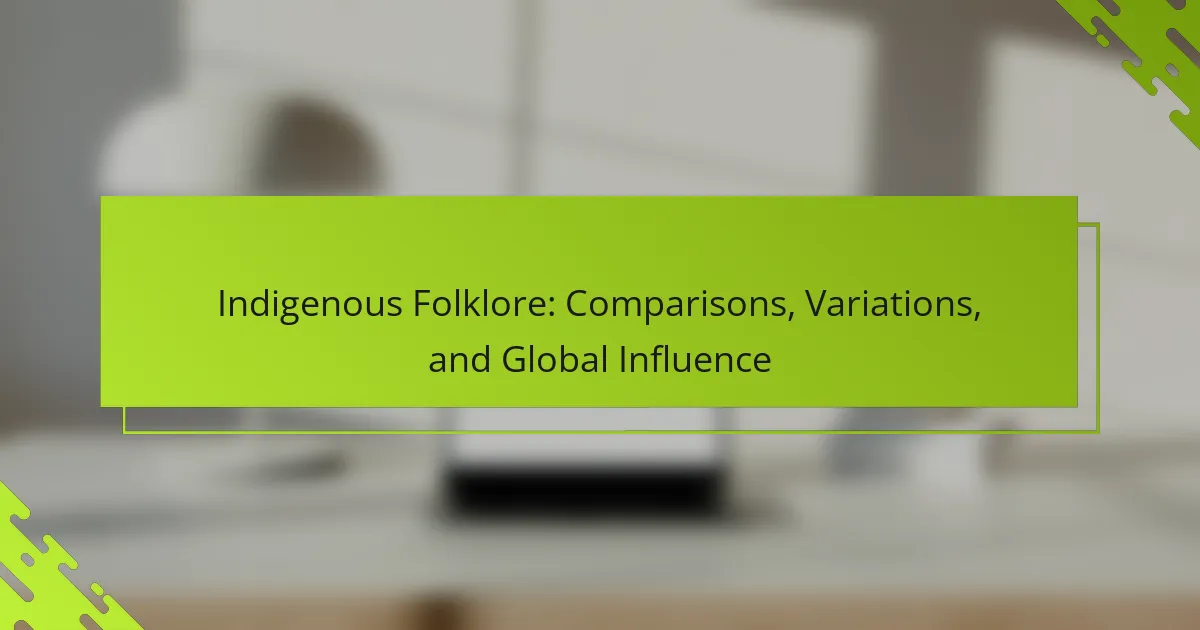Indigenous folklore plays a crucial role in shaping cultural identity and community values. This article explores the unique narratives and characters that define Indigenous cultures, notable variations in storytelling practices, and the global influence of these narratives on literature and art. It also addresses the challenges faced by Indigenous storytellers in preserving their rich traditions while highlighting the importance of cross-cultural appreciation and environmental themes within these stories.
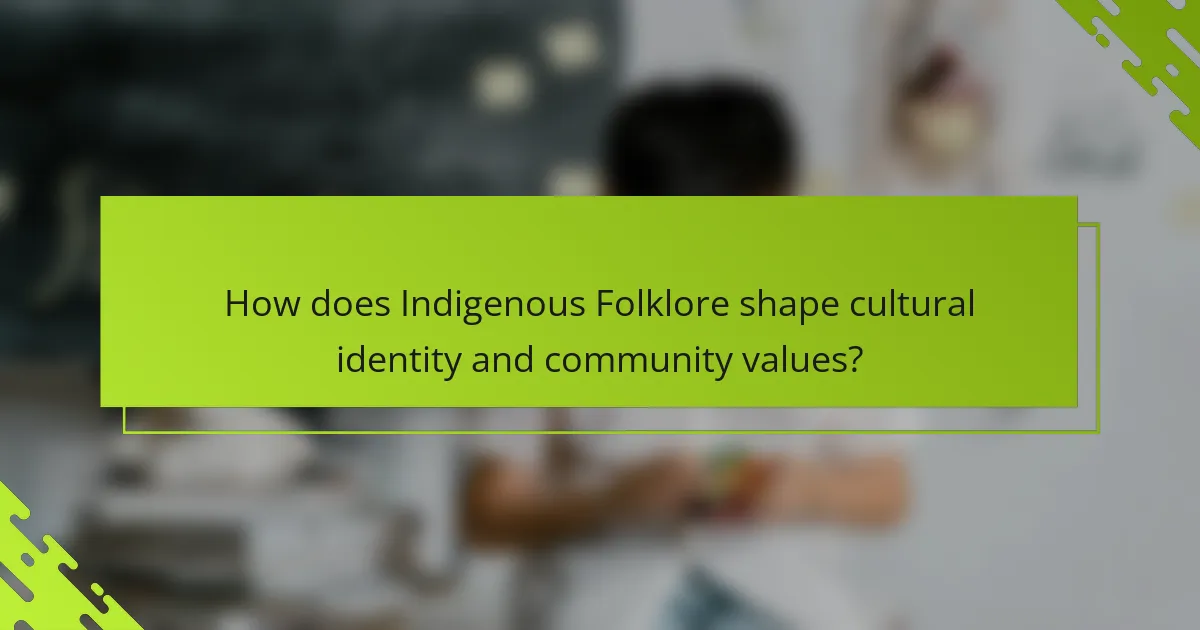
How does Indigenous Folklore shape cultural identity and community values?
Indigenous folklore profoundly shapes cultural identity and community values by preserving traditions and fostering a sense of belonging. Stories passed down through generations create shared histories, reinforcing social norms and collective morals. For instance, folklore often emphasizes respect for nature, guiding sustainable practices within communities. Unique attributes, such as oral storytelling traditions, further distinguish Indigenous cultures, ensuring their values remain vibrant and relevant. The global influence of these narratives promotes cross-cultural understanding and highlights the importance of diversity in human experiences.
What are the common themes found in Indigenous Folklore across different cultures?
Common themes in Indigenous folklore include creation myths, the significance of nature, moral lessons, and the importance of community. These narratives often reflect shared values and beliefs across cultures. For example, many Indigenous stories emphasize the connection between humans and the environment, illustrating respect for nature. Additionally, themes of transformation and the supernatural frequently appear, showcasing the unique attributes of each culture’s worldview. The variations in storytelling techniques and character archetypes highlight the rich diversity within Indigenous folklore globally.
How do oral traditions influence the preservation of Indigenous Folklore?
Oral traditions significantly influence the preservation of Indigenous folklore by ensuring its transmission across generations. These traditions rely on storytelling, rituals, and communal participation, which foster cultural identity and continuity. Oral narratives adapt over time, incorporating contemporary experiences while maintaining core values and teachings. This dynamic process allows Indigenous communities to preserve unique attributes of their folklore, such as local myths and legends, while also showcasing variations influenced by geography and cultural exchange. As a result, Indigenous folklore remains a living entity, reflecting the ongoing relationship between people and their environment.
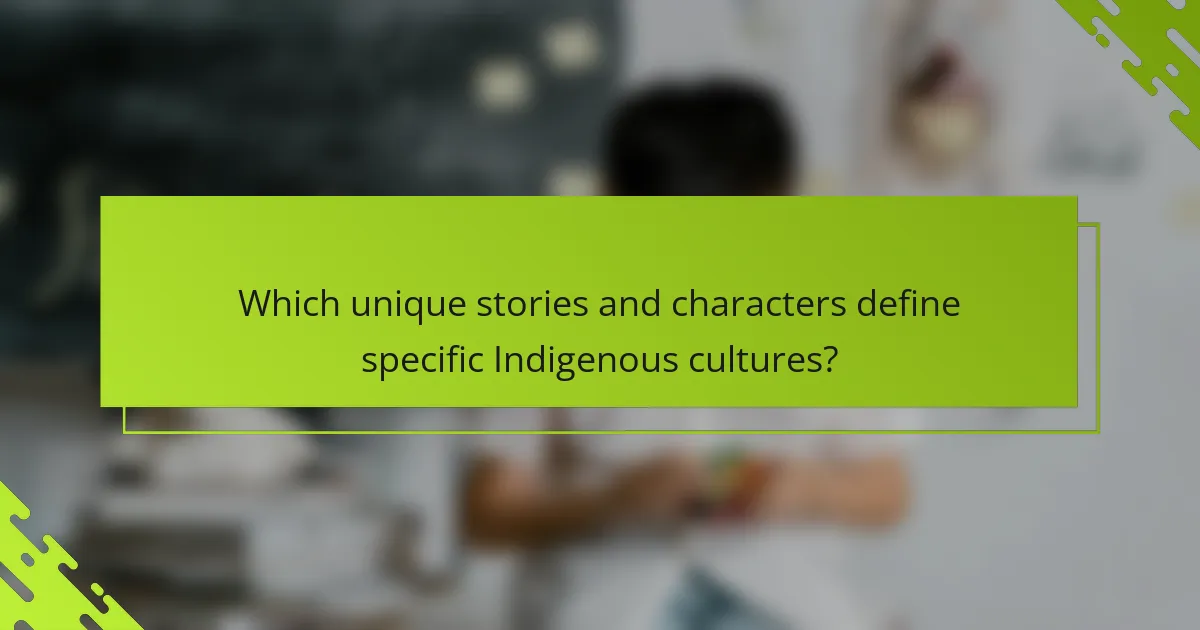
Which unique stories and characters define specific Indigenous cultures?
Unique stories and characters define Indigenous cultures through distinct narratives that reflect their values and beliefs. For instance, the trickster figure in various Indigenous folklore, such as Coyote in Native American tales, embodies lessons about morality and survival. Each culture’s stories often feature unique attributes, like the Dreamtime of Aboriginal Australians, which connects spirituality to the land. Rare characters, such as the Raven in Northwest Coast mythology, symbolize transformation and creation, showcasing the diverse ways Indigenous peoples interpret their world. These narratives not only preserve cultural identity but also influence global storytelling traditions.
What role do trickster figures play in various Indigenous narratives?
Trickster figures in Indigenous narratives serve as agents of change and transformation. They challenge societal norms, reveal truths, and often embody duality, representing both chaos and wisdom.
These figures, like Coyote in Native American folklore or Anansi in African tales, illustrate the complexities of human nature. They frequently use humor and cunning to navigate their worlds, teaching lessons through their misadventures.
The presence of tricksters varies across cultures, yet they share common attributes, such as their ability to subvert authority and provoke thought. This role emphasizes the importance of adaptability and resilience in the face of challenges.
Overall, trickster figures highlight the rich tapestry of Indigenous storytelling, reflecting cultural values and the human experience. Their narratives continue to influence contemporary storytelling globally, showcasing their enduring relevance.
How do creation myths vary among Indigenous groups?
Creation myths among Indigenous groups vary significantly, reflecting diverse cultural values and environmental contexts. Each group has unique narratives that explain the origins of the world, humanity, and natural phenomena. For instance, the Navajo creation story emphasizes harmony with nature, while the Inuit myths often focus on survival in harsh climates. These variations highlight the unique attributes of each culture’s worldview and their relationship with the land. Additionally, some myths share common themes, such as the emergence of life from water, demonstrating rare similarities across different traditions. The study of these myths reveals the rich tapestry of Indigenous folklore and its global influence.
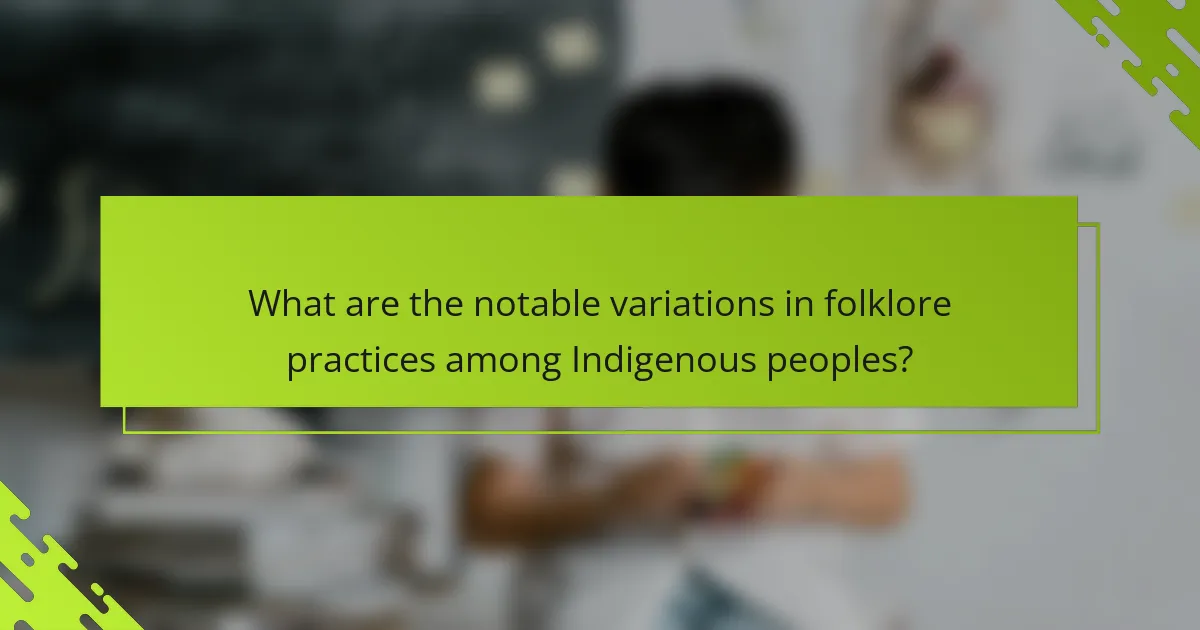
What are the notable variations in folklore practices among Indigenous peoples?
Notable variations in folklore practices among Indigenous peoples include distinct storytelling traditions, ritual ceremonies, and unique mythological figures. Each culture reflects its environment, history, and social structure. For instance, the oral traditions of the Navajo emphasize harmony with nature, while the Inuit folklore centers on survival in harsh climates. Further, some tribes incorporate dance and music into their storytelling, enhancing communal bonds. These practices showcase the diversity and richness of Indigenous cultures globally.
How does the storytelling format differ between cultures?
Indigenous storytelling formats vary significantly across cultures, reflecting unique traditions and values. For instance, oral traditions in Native American cultures often emphasize communal experiences, while Australian Aboriginal stories incorporate Dreamtime elements that connect spirituality and land. African folklore frequently utilizes rhythmic language and performance, enhancing engagement. Each culture’s storytelling serves to preserve history, impart morals, and strengthen community bonds, showcasing diverse narrative techniques and themes.
What are the different mediums for sharing Indigenous Folklore?
Indigenous folklore is shared through various mediums including oral traditions, written texts, visual arts, and digital platforms. Oral storytelling remains a primary method, preserving cultural narratives across generations. Written collections and anthologies document these stories, allowing wider access. Visual arts, such as paintings and carvings, convey folklore themes symbolically. Digital platforms have emerged, enabling broader dissemination and engagement with Indigenous narratives globally.
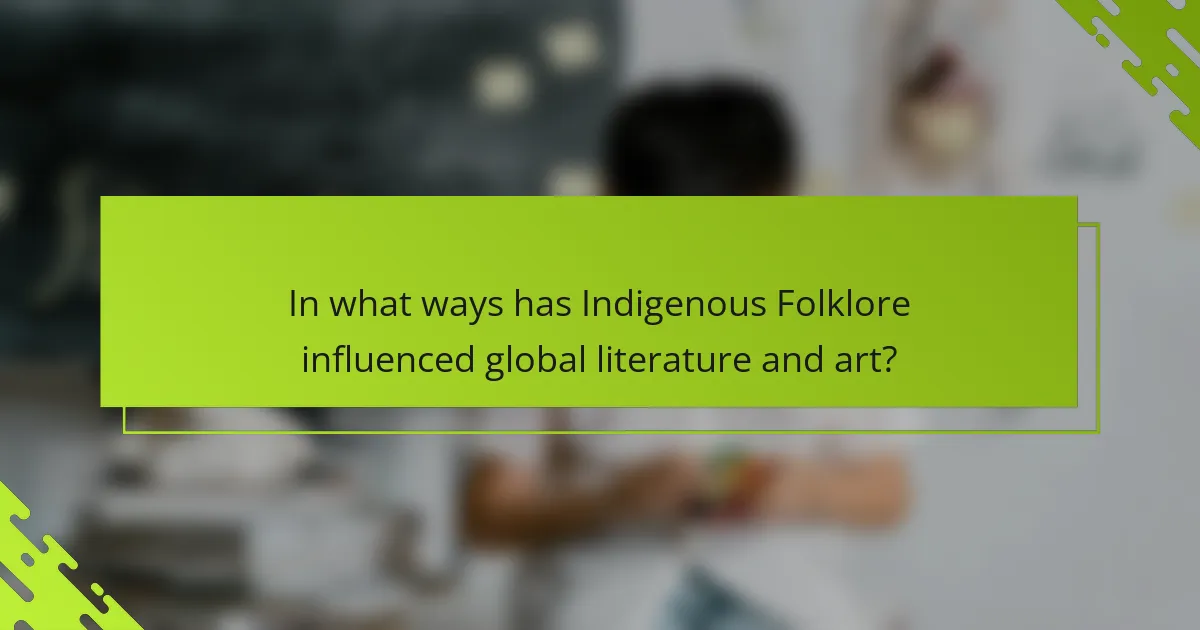
In what ways has Indigenous Folklore influenced global literature and art?
Indigenous folklore has profoundly influenced global literature and art through themes, motifs, and storytelling techniques. Many contemporary works draw upon Indigenous narratives, blending cultural elements with universal human experiences. For instance, the use of oral traditions in storytelling has inspired novelists and filmmakers worldwide.
Notable authors like Toni Morrison and Sherman Alexie integrate Indigenous perspectives, enriching the literary landscape. Visual artists, including Norval Morrisseau, have incorporated Indigenous symbols and stories, creating a dialogue between cultures. This cross-pollination fosters a greater appreciation for diversity and cultural heritage in global art.
Furthermore, Indigenous folklore often addresses environmental themes, promoting a connection to nature that resonates globally. As a result, these narratives encourage a more sustainable worldview, influencing both literature and art movements focused on ecological consciousness.
Which contemporary authors draw inspiration from Indigenous stories?
Contemporary authors drawing inspiration from Indigenous stories include Louise Erdrich, Tommy Orange, and Sherman Alexie. These writers weave Indigenous themes and narratives into their works, reflecting cultural heritage and contemporary issues. Their storytelling showcases the global influence of Indigenous folklore, often blending traditional elements with modern perspectives. For example, Erdrich’s novels highlight Native American experiences, while Orange’s “There There” addresses urban Indigenous identity. This connection enriches the literary landscape and fosters greater understanding of Indigenous cultures.
How do Indigenous motifs appear in modern visual arts?
Indigenous motifs play a significant role in modern visual arts by serving as symbols of cultural identity and heritage. Artists incorporate traditional patterns and stories, blending them with contemporary styles to create unique expressions. This fusion fosters a dialogue between past and present, enriching the global art landscape. For example, Indigenous artists often reinterpret traditional motifs in modern mediums, such as digital art or sculpture, making them accessible to wider audiences. This evolution highlights the ongoing influence of Indigenous folklore in shaping artistic narratives worldwide.
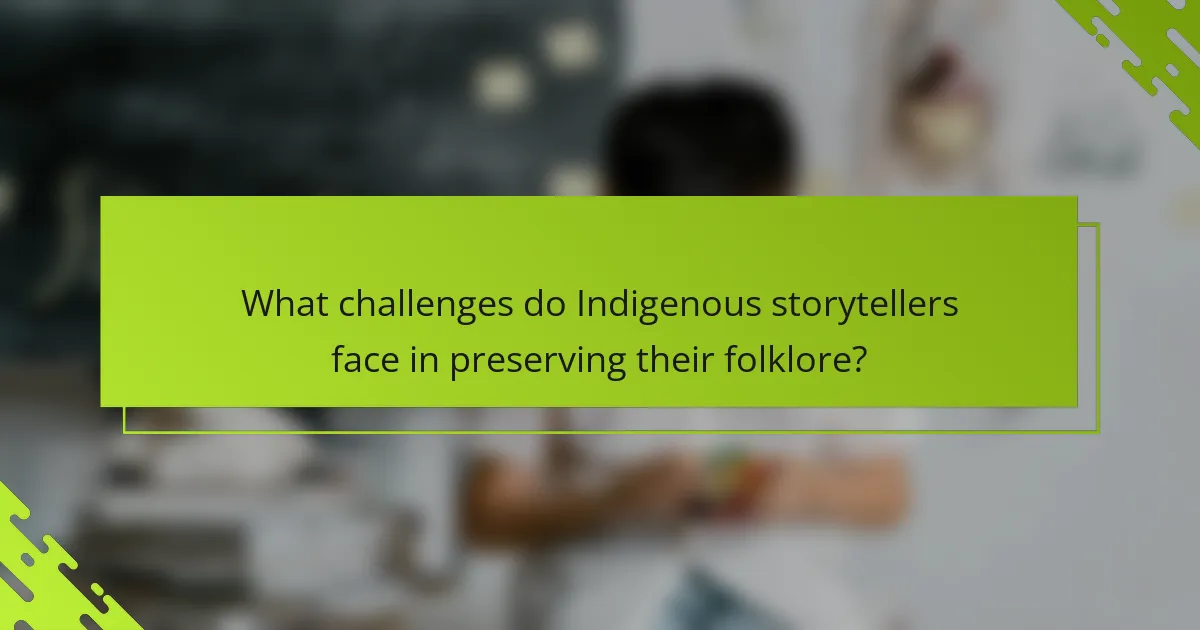
What challenges do Indigenous storytellers face in preserving their folklore?
Indigenous storytellers face numerous challenges in preserving their folklore, including cultural appropriation, language loss, and limited access to resources. These obstacles hinder the transmission of traditional narratives to future generations. Additionally, modern influences often overshadow Indigenous stories, diluting their significance. The lack of recognition and support for Indigenous voices further complicates efforts to maintain and celebrate these rich cultural heritages.
How has globalization impacted the transmission of Indigenous Folklore?
Globalization has significantly enhanced the transmission of Indigenous folklore by facilitating cross-cultural exchanges. This process has led to the adaptation and reinterpretation of traditional stories, allowing them to reach broader audiences.
As a result, Indigenous narratives often blend with global themes, creating unique variations. For instance, storytelling techniques may incorporate modern media, such as film and digital platforms, which further disseminate these cultural expressions.
However, this globalization can also pose challenges, such as the risk of cultural appropriation and dilution of original meanings. Indigenous communities strive to maintain authenticity while navigating these global influences.
Ultimately, the impact of globalization on Indigenous folklore reflects a complex interplay between preservation and transformation, shaping how these stories are told and understood today.
What measures are being taken to protect Indigenous narratives?
Efforts to protect Indigenous narratives include legal protections, community-led initiatives, and educational programs. Indigenous groups advocate for intellectual property rights to safeguard their stories. Collaborations with academic institutions foster respectful representation and preservation of folklore. Digital archiving projects aim to document and share narratives while ensuring community control over their dissemination.
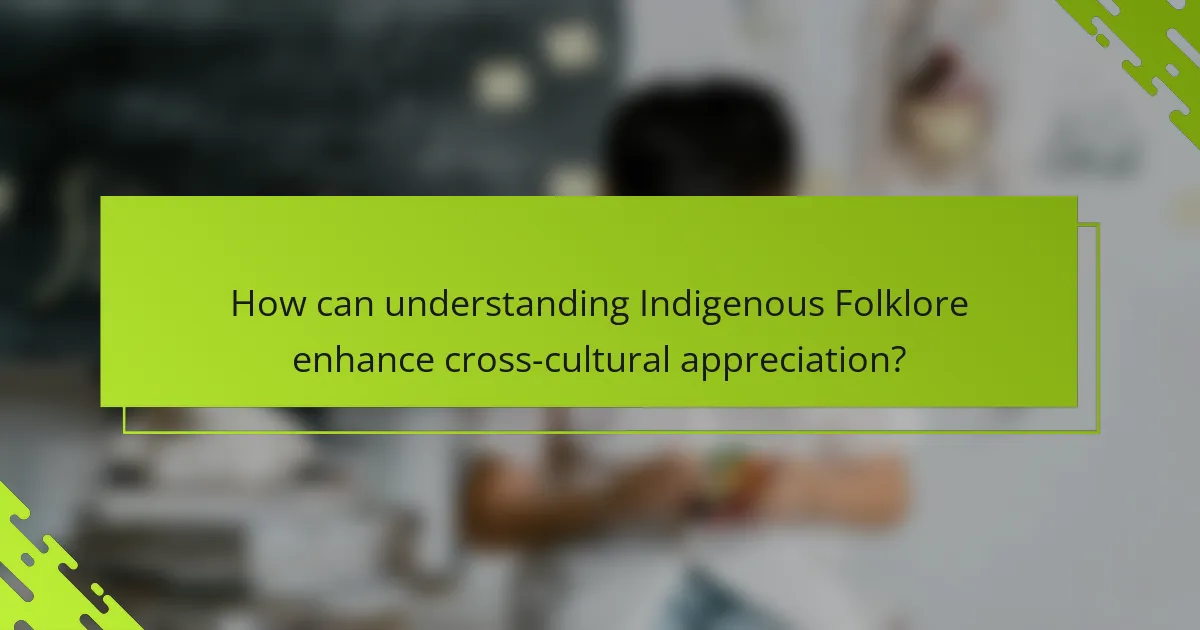
How can understanding Indigenous Folklore enhance cross-cultural appreciation?
Understanding Indigenous Folklore enhances cross-cultural appreciation by fostering respect for diverse narratives and traditions. It reveals unique worldviews and values that shape community identities. Engaging with these stories promotes empathy and understanding, bridging cultural divides. For example, Indigenous tales often illustrate harmonious relationships with nature, encouraging sustainable practices. This perspective enriches global dialogues about environmental stewardship and cultural preservation.
What are best practices for engaging with Indigenous stories respectfully?
Engaging with Indigenous stories respectfully involves understanding their cultural significance and context. Prioritize listening to Indigenous voices and perspectives. Acknowledge the diversity of Indigenous cultures and avoid generalizations.
1. Research the specific culture and traditions before sharing stories.
2. Seek permission from Indigenous storytellers when using their narratives.
3. Be mindful of the language used and avoid stereotypes.
4. Support Indigenous creators and communities by promoting their work.
5. Participate in cultural events to deepen understanding and appreciation.
6. Reflect on your own biases and approach stories with humility.
How can educators incorporate Indigenous Folklore into curricula?
Educators can incorporate Indigenous folklore into curricula by integrating storytelling, cultural context, and comparative analysis. This approach fosters respect and understanding of diverse perspectives.
1. Use storytelling as a teaching tool to convey moral lessons and cultural values inherent in Indigenous folklore.
2. Include discussions on the historical and cultural significance of various Indigenous stories to enhance contextual understanding.
3. Facilitate comparative analysis of Indigenous folklore with other global narratives, highlighting similarities and differences in themes and values.
4. Encourage students to create their own stories inspired by Indigenous folklore, promoting creativity and personal connection to the material.
What common mistakes should be avoided when discussing Indigenous Folklore?
Avoid generalizations, cultural appropriation, and misrepresentation when discussing Indigenous Folklore. Respect the diversity of traditions and narratives across different tribes. Acknowledge the oral history aspect, which varies significantly among communities. Ensure accurate representation by consulting Indigenous voices and sources. Recognize that folklore is not static; it evolves and adapts over time.
